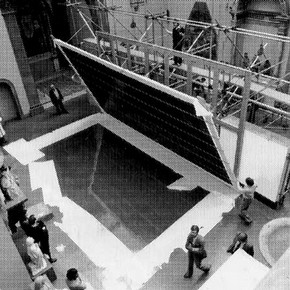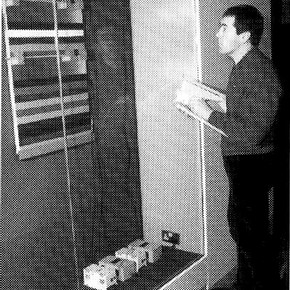Conservation Journal
October 1994 Issue 13
The Organics Group: From the Top down & the Bottom up
The creation of three new general management posts, recommended following a Cabinet Office review, was seen by some as a straight loss of resources available to practical conservation. Although I was not prepared for this as my next career move, I saw it as an opportunity to achieve better targeting of limited resources. The very act of making our Collections available for study and enjoyment leads to their deterioration. My ambition is to help the Museum fulfil its Mission at the smallest cost, in terms of damage and loss of information, to the Collections. A stronger management team should lead to improvements in the state of the Collections and in the Museum's ability to achieve its objectives. High levels of job satisfaction and good opportunities for personal development are essential to this aim.
Responsibilities and activities
The Organics Group brings together three Conservation Sections: Paintings, Furniture, and Textiles. Although each Section serves a major Collection, the Organics Group provides a regular service for at least eight of the 12 main Collections and branch museums. The new structure can help our current efforts to clarify and simplify the programming of work and allocation of resources across the board.
The Paintings Collection includes wooden panels, miniatures in oil and works on canvas. Textiles Collection contains a wide range of traditional materials in costumes, accessories, tapestries and carpets and an increasingly wide range of modern, synthetic materials in both costume and accessories. Furniture Collection contains an enormous range of materials besides wood, not all of them organic, though the nature and behaviour of wood underlie most problems we have to solve. The remaining Collections, such as those of the Museum of Childhood at Bethnal Green and the Theatre Museum in Covent Garden, largely duplicate the variety of size, structure and material found in the other collections. Japanese armour from the Far Eastern Collection offers the severe conservation challenge of degraded silk associated with metal and degraded oriental lacquer on wood. The Indian and South East Asian Collection is large and diverse and, unlike most of the Collections, only a small part of it can be on display at a time. Rotation of objects helps to bring this magnificent collection to public attention.
Object-related Conservation accounts for about 60 percent of our time and includes the technical examination, repair, cleaning, restoration, and mounting of objects and essential documentation. Our practical work comes from new gallery projects, exhibitions, loans (increasing), and routine upkeep of the Collections (decreasing).
The Museum manages an increasingly ambitious programme of loans including large shows touring overseas. Conservators are among those responsible for ensuring the safety of objects transported and displayed overseas. Once a new gallery or major loan has been approved for development, conservators will examine objects to assess their suitability for inclusion and estimate the time required to bring them to display condition. If we honestly believe objects to be unsuitable for the proposed project, because they are inherently weak or unstable or because their condition cannot be improved, we will advise accordingly. This makes an important and relatively inexpensive contribution to preventive conservation.
The thorough technical examination of objects helps to establish important features of identity and condition of objects that are needed to make rational decisions about treatment. We aim to ensure that objects are stable, in optimum visual condition, and technically understood. As much information is gathered as is needed by the conservator to assess the state of the object and make a responsible decision about treatment. The development of an ethics checklist of points to consider before treatment is proving helpful in this respect. Documentation is an essential complement to examination. Facilities exist in each section for routine examination under magnification and in raking light and uv. The Paintings Section contains facilities for X ray examination and a sensational infra-red video unit that is a powerful tool in revealing drawings underlying paint layers.
Along similar lines, Paintings Conservation is involved in the development and application of microclimates to provide effective control of relative humidity in the framed environment of wooden panel paintings such as the Tintoretto self-portrait that have to travel on loan. The possible risks of pollution inside such microclimates are now also being investigated. The use of new cleaning methods such as solvent gels, emulsions, and enzymatic cleaning techniques has been developed from the pioneering work by Richard Wolbers and has been taught by a conservator of paintings to others in the Department. There are several stakeholders in the development of a universal hanging system for paintings. Close collaboration between Curator and Conservator has lead to the highly successful "Recent Discoveries" mini-exhibition series that is to be found outside the Museum Restaurant. This explains discoveries made as consequence of conservation practice and highlights consequences of conservation for the way works of art are perceived, interpreted, and displayed.
People
There are nine permanent posts in Textiles Conservation, six in Furniture and three in Paintings, roughly in line with the size of the Collections served. There have been considerable recent changes in staff and nearly 160 years of experience will have been lost in a period of four years.
In Paintings Section Peter Young has retired and Susannah Edmunds has taken over officially as Head of Section. Katherine Donaldson is a much needed and long wanted conservation technician working largely on frames. There is generally one intern working in this section.
In Furniture, John Kitchin has recently retired as Head of Section A tremendous programme of rebuilding the section has got off to an excellent start with the appointment of Albert Neher and Tim Hayes. There is one V&A/RCA MA student and an intern. Furniture Conservation has also accepted two students on short placements this Autumn and is negotiating with two Course Leaders on conservation courses outside the Museum for suitable students to work on suitable objects outside the Museum. This will continue the collaboration between curator and conservator so carefully fostered by John Kitchin and Sarah Medlam of the Furniture Collection and so much valued by both parties.
Textiles has sustained a heavy loss with the departure of Nicola Gentle from the Osterley workshop. A 9-month contract post in the conservation of upholstery and furnishing textiles has been created. The Section makes considerable use of contract staff and has put tremendous energy into training both RCA/V&A Conservation Course students and interns. It alone of the Sections in the Group will be moving into the Centre of Research and Conservation and because of this will suspend these training activities when the present commitments have been fulfilled.
Plans are forming to allow us to work across boundaries within the Group. Worries are growing about how we will cope with the analysis of fibres, pigments, and wood samples when one of our senior scientists, Jo Darrah, retires in 1997.
Concerns and aims

Fig.2. Painting, oil on canvas (P36 1926): a copy of Raphael's 'School of Athens' by Anton Raphael Mengs. (click image for larger version)
The Museum's planning is seen by many in the Group as too much of a top down process, with the risk that those who are directly responsible for achieving the goals will not have been fully involved. It is important to realise that we are all more committed to achieving goals that we help to establish. The Organics Group has recently tried to develop aims and objectives that could form part of the Department's plan to be submitted to the Museum's Strategic Planning Team.
We should seek to develop non-invasive, objective, and reliable methods of measuring and describing the condition of objects. We could then begin to quantify the effect of alternative ways of using objects in fulfilment of the Museum's Mission. This would help us to maintain the correct balance between use and preservation of the collections.
Proper costing and allocation of resources was wanted with a better mechanism for negotiating with clients and more time for research and development. The Heads of Group are currently discussing some ideas with the Collections. The basic principle involves budgeting time and other resources in the same way as is done for financial resources.
Close liaison between Collections and Conservation was another desire expressed by the Group. Although all objects are equal than others; in the event of a fire we should know what we would most wish to save. We may move towards identifying masterpieces that we would wish always to be in condition grade one or two. If we cannot give everything equal treatment then at least we can advise on the best way to slow rates of deterioration. This can often be done by improved storage. Cold storage of furs, for example, might form part of a preservation strategy.
Training is one of our main outputs. It was felt that the RCA/V&A Conservation Course needs to be much more fully integrated into the work of the Department with more time scheduled for students to have access to conservation expertise and more contact with curators. Students could provided leverage in the Department to help us integrate theoretical ideas more fully into conservation practice and to ‘spread the word’ of conservation by making us aware of developments in the relevant fields.
For me the last year has been a period of development and learning, pain and growth, a process that I am sure will continue for some time to come. I am learning particularly that change must be embraced by the majority and must take place at a realistic pace if it is to succeed. The best systems are simple and clearly understood by all who must use them.
